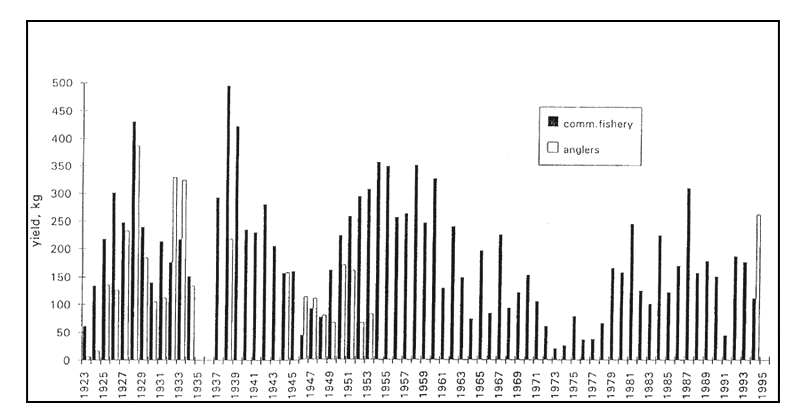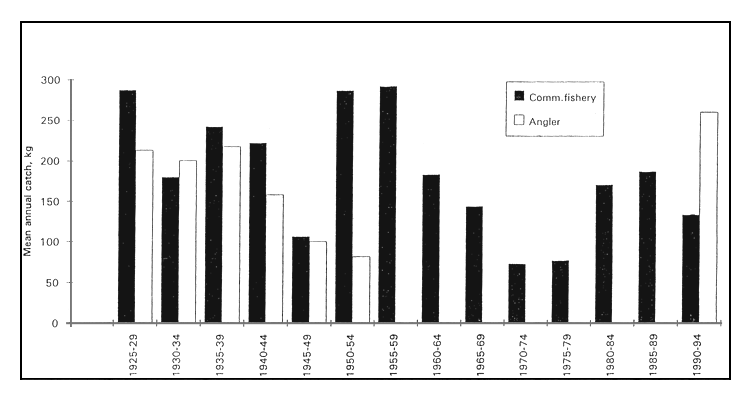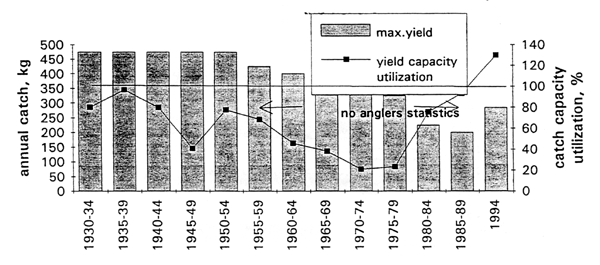R. KNÖSCHE
Institut für Binnenfischerei e.V., Jägerhof am Sacrower See, D-14 476 Groβ Glienicke, Germany
The commercial and recreational fisheries in North German lakes focus mainly on pike. Investigations of 322 North German lakes and of a special overfishing experiment with pike in a small lake (Barthelmes, 1993) showed:
A similar overfishing experiment was started in Lake Sacrow near Potsdam in 1992. Lake Sacrow is a rather deep lake of 100 ha in area with a narrow littoral zone. Its trophic status moved from mesotrophic/eutrophic during the first half of this century to eutrophic/hypertrophic in the 1980s.
In 1992 and 1993 there was an intensive commercial fishery for pike and pike angling was not allowed. In 1994 commercial fishing returned to normal levels and fishing for pike by the recreational fishery was allowed again.
During the first two years there were no significant signs of overfishing. The mean individual weight of pike in the catches decreased only slightly. The condition of fish and the yield per CPUE (catch per unit effort) did not change.
In 1994 the commercial pike yield decreased. However anglers captured more than twice as much. Decreasing CPUE with decreasing effort points to overfishing of the pike population (Table 1).
Table 1 Catch effort and pike catch per CPUE in Lake Sacrow
| 1992 | 1993 | 1994 | ||
| Effort | E1 | 48,09 | 39,56 | 30,31 |
| CPUE | kg/E | 3,84 | 4,07 | 3,63 |
1 weighted arithmetic mean of the applied fishing gears(seine, gill nets and electrofishing)
The standing crop of the pike population was estimated by tagging in 1993 and 1994. In addition the body size composition of the stock and the individual growth were ascertained. With these data we computed the yearly increment of the pike stock and its P/B-coefficient. Table 2 shows these values compared with the real catch. It shows overfishing in 1994 when pike angling was again allowed.
Table 2 The standing crop of pike population of Lake Sacrow, its yearly increment, P/B-coefficient compared with the real catch
| 1993 (kg) | 1994 (kg) | |
| Standing crop | 470 | 500 |
| Yearly increment | 220 | 220 |
| P/B-coefficient | 0.47 | 0.44 |
| Pike yield | 161 | 370 |
Table 3 shows the stock evaluation by habitat saturation method. In 1992 and 1993 the actual yield was distinctly lower than the maximum potential yield. However the maximum yield was completely exploited in 1994. This indicates the beginning of overfishing of pike.
Table 3 Evaluation of the pike stock by pike saturation
| 1992 | 1993 | 1994 | |
| Suitable habitat area (ha) | 4,26 | 5,36 | 7,631 |
| Pike saturation (kg) | 425–640 | 535–805 | 765–1 145 |
| Potential pike yield (kg) | 140–215 | 180–270 | 255–380 |
| Actual pike yield (kg) | 185 | 161 | 370 |
These results pose the question as to whether or not pike stocks can be overfished by angling.
Catch statistics of the commercial fishery since 1923 are almost complete and anglers' statistics are available for 23 years in Lake Sacrow (Rümmler, 1949). Fig. 1 illustrates pike catches over the past 70 years. There are considerable fluctuations from year to year but also long time variations. Overfishing could be one reason for it.
When annual yields are condensed into five-year-means the same long time variations are present (Fig. 2). Total pike catch exceeded the 5 kg/ha-line three times in the period 1925, 1931 and 1934. For two of these events we have information about the anglers' CPUE. Immediately after exceeding the 5 kg-point the anglers' CPUE has clearly declined (Fig. 3). On the other hand, during the early 1950s, when pike catches were moderate (below 4 kg/ha), the CPUE of the commercial fishery by electrofishing increased although the anglers' CPUE was fluctuating. There is a vegetation map of Lake Sacrow from 1930 (Wundsch & Meseck, 1940) which allows evaluation of suitable habitat area. It is also possible to make a rough assessment of the suitable pike area by interpolation regarding the trophic level up to the 1990s when a new habit area evaluation was made (Rümmler, 1995). In Fig. 4 a stock evaluation according to the habitat saturation method was carried out. Besides year 1994 there are four, five-year pentads when the pike stock was probably overfished - 1925–29, 1935–39, 1950–54 and 1985–89. This corresponds with the curve in Fig. 3.
The following conclusions are drawn from these results:
These conclusions are drawn on the basis of incomplete statistics only for one lake and are thus preliminary and subject to further investigation.
References
Barthelmes, D., 1993. Häufigkeit und Förderfähigkeit des Hechtes in Seen. Vortr. Tag d. Binnenfischers, Güstrow, 16.2
Rümmler, H.F., 1949. Die Fangergebnisse der Sport- und Berufsfischerei auf dem Sakrower See bei Potsdam in den Jahren 1923 is 1948 und die Auswertungsmöglichkeiten der Anglerstatistik. Z.Fischerei, S. 453–467
Rümmler, F., 1994. Arbeitsbericht zur wissenschaftlichen Begleitung der Sanierung des Sacrower Sees durch den Betrieb einer Tiefenwasserbelüftungsanlage. Institut für Binnenfischerei, 62 S
Wundsch, H.H. & Meseck, G., 1940. Zwölf Jahre Fischerei auf dem Sacrower See bei Potsdam. Z. Fischerei 37, 3, 331–379

Fig. 1 The annual yield of pike in Lake Sacrow (100 ha)

Fig. 2 Mean pike catch by the commercial fishery and anglers in Lake Sacrow (100 ha)

Fig. 3 The total pike catch and specific anglers catch (CPU) in Lake Sacrow

Fig. 4 Maximum yield capacity of the pike in Lake Sacrow and its utilization by the fishery